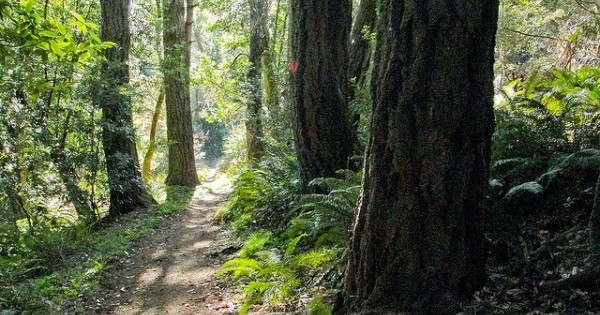
If you’ve been in the Pacific Northwest you’ve seen a Douglas-fir. It’s a conifer of course—needles and cones. It’s our main tree and it grows in woods, in city parks, and on the street.
In the woods it grows straight and tall and the lower branches stick straight out from the trunk like a many-armed man being frisked. But the tree is self-pruning, so what you often have in a younger tree is a straight-up trunk with knots where branches once grew, the needled top susurrus in the wind. To know for sure you’re standing under a Doug-fir, look at the oval-shaped cones on the ground. They have thin unmistakable three-pointed bracts sticking up between the scales.
Why learn a tree at all? A tree is a tree, right? Yet any one object, when scrutinized, opens the door to its worlds. To its type and its form and its way of life. To its deep past and if it’s alive, to its reproductive and genetic history. The Doug-fir (Pseudotsuga menziesii) is not actually a fir tree, and it’s incorrect to refer to its common name without the Doug- or Douglas-. It’s a member of the pine family. Pines are gymnosperms, seed plants with “naked” seeds (not enclosed in ovaries as are seeds of dahlias and dogwoods and daisies). Doug-fir cones have a pair of naked seeds at the base of their cone-scales.
The tree can live for a thousand years. And its fossil remains date to 50 million years ago. So the Douglas-fir scraping the sky outside my window had a long history before it became a force in our history. And it did become a force in our history.
In the Pacific Northwest the tree was gigantic and abundant. Fire was part of its ecology: the thick bark of old trees resists burning, and its saplings must have sunlight. Fire can clear its shady understory of hemlock and cedar so allowing Doug-fir seeds to sprout and the saplings to survive. Northwest Indians used the Douglas-fir in minor ways, but preferred cedar because cedar is more beautiful and easier to work with stone tools. They fabricated longhouses, garments, canoes, baskets, and ceremonial articles from western red cedar.
The first European to describe Douglas-fir trees was Archibald Menzies, a Scottish naturalist who arrived in the Pacific Northwest in 1792 aboard the vessel of the English Captain George Vancouver. Menzies supplied the Latin name and gathered specimens to take home, all of which died. Next, in the 1820s, came the tree’s eponym, David Douglas, another Scottish naturalist. Douglas sent living seeds back to Scotland where the resulting trees are now ubiquitous.
Douglas-fir became the most extensively harvested tree in the Northwest. Think Weyerhaeuser. Think old photos of tiny men with their tiny axes standing beside building-sized stumps. Think clear-cut—that unnatural disaster. Think tree farm. Think house frames, two by fours, telephone poles, fence posts, plywood.
In the Pacific Northwest, before every last centuries-old tree was cut down, the spotted owl controversy rose up and raged, pitting the environment against an industry and its jobs. Endangered spotted owls (and a good number of other species) live only in old-growth forest. It’s an intense ecosystem that can’t be recreated. Ultimately the owl won some protection (under NEPA—the National Environmental Policy Act) along with its giant old trees (though threats continue).
Here, in the young urban forest of my Seattle street, I see the Douglas-fir all around. It’s habitat, wood, shade. It’s part of our history, part of our world, even part of who we are.
Because of the July 4th holiday, Priscilla Long’s next Science Frictions essay will appear Wednesday, July 11.

